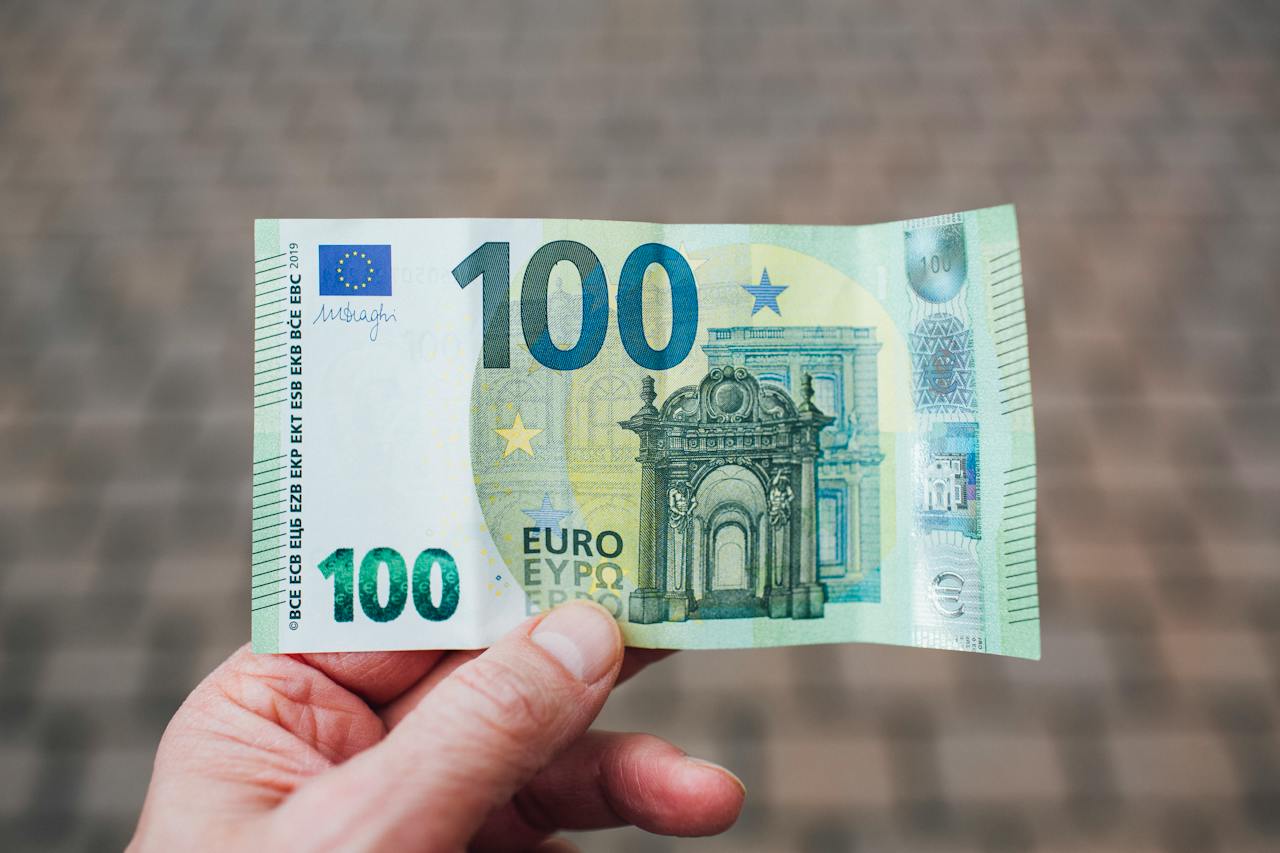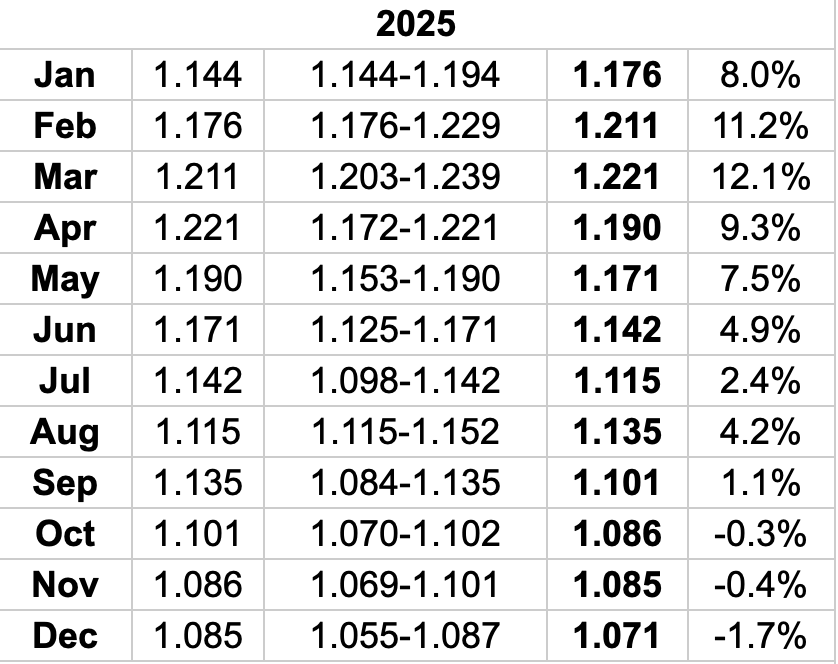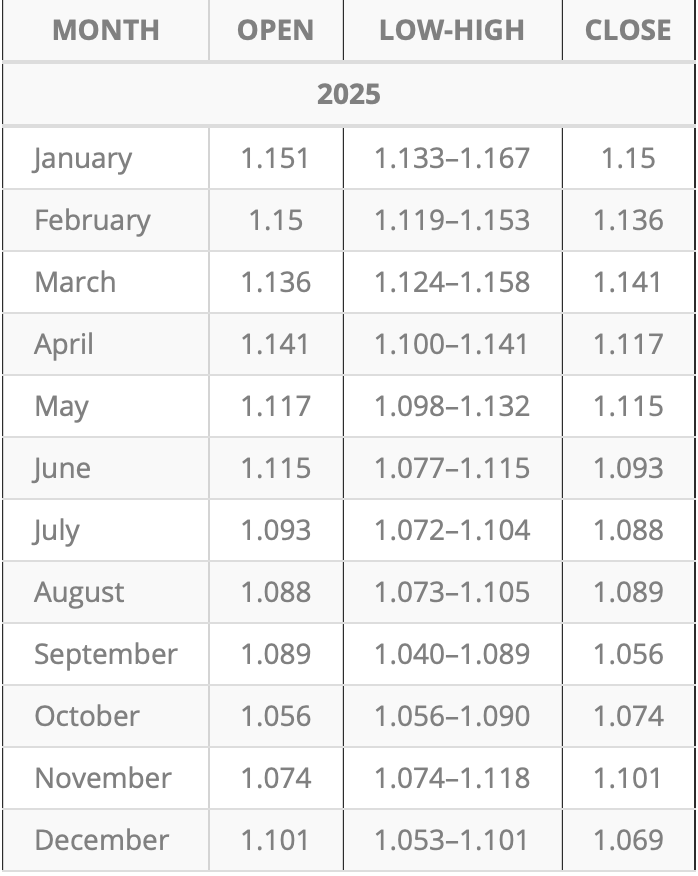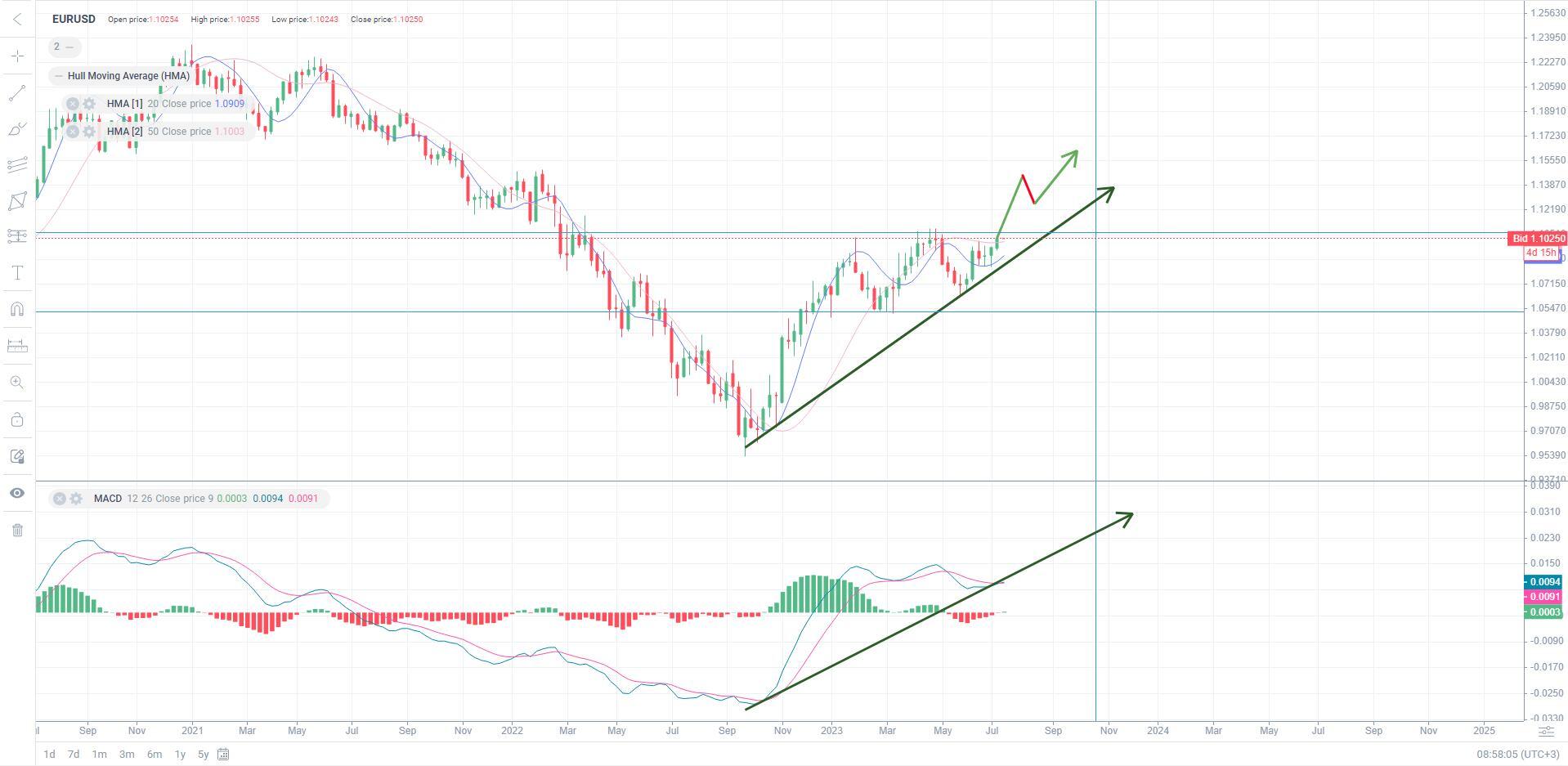Euro (EUR) Forecast for 2025, and Prediction for EUR to USD

One of the world’s major currency pairs, euro/dollar is the most popular choice of Forex traders. Millions try to predict the rate in both the short and long term. This article provides an insight into how much the euro will cost in 2024, 2025 and beyond. Also, you will learn how the US and EU economies influence the EUR/USD pair, together with global market sentiments and other crucial factors.
Table of Contents
How did EUR trade in 2022?
Was USD predictable in 2023?
What has been driving the value of EUR?
Euro in 2023
Euro forecast: Price prediction for 2024 and beyond
Euro forecast 2025
Characteristic features of the EUR/USD pair
EUR/USD price prediction for next three months
Monthly EUR/USD price forecast for 2024
Conclusion
FAQ
How did EUR trade in 2022?
EUR/USD declined steadily over the whole year of 2022. With a starting cost of $1.137, it crawled to $1.15 in early February and subsequently dropped to $1.035 in May (this was the lowest since January 2017).
Following that, there was a recovery attempt, with the pair reaching a high of $1.065 in June. However, in July, the EUR connection with USD broke, signifying a 20-year low.
By August, EUR/USD had recovered to $1.036, although the situation was temporary. Within a week, the currency pair saw a steep decline, and in the end of August, it broke parity once more.
Subsequently, it dropped below the $0.99 threshold, reaching a 20-year low of $0.9881 in September, when Russia ceased supplying gas to Europe through its primary pipeline.
The ECB's 75 bp boost then sparked a five-day rally in the currency pair, which peaked at $1.01977 on September 12 before it could test parity once more, and hit a YTD low of $0.95 at the end of September.
Once again ending the year over parity at $1.0726, EUR/USD maintained a 9.4% gain over the course of three months.
Was USD predictable in 2023?
In international markets, the US currency has fluctuated less under the current president’s leadership. His attention to domestic matters and his positive engagement in trade discussions had a good impact on financial markets. Yet, the demand for USD as a safe-haven asset has lowered after easing market tensions.
In addition, President Biden leveraged a US stimulus package that raised the country's budget deficit while aiding in the economy's recovery from the Covid-19 pandemic. Federal Reserve Chairman Jerome Powell announced that interest rates would not be raised until the end of 2023, which took a toll on the value of the dollar as well.
Analysts are sure that the USD market has positive projections. Many traders want to make long-term purchases or trades. How long such transactions will last depends on the second currency in the pair. (The Japanese yen and British pound are among the most widely traded currencies.)
The use of technical analysis in predicting is also crucial. Trading tools and patterns help analysts and big analytics companies to examine historical data and forecast future patterns of the market, as well as a single currency. This aids traders and investors in making wise choices.
The 30-day euro to dollar forecast is optimistic due to previous actions and investments. Even if there are many dangers associated with trading forex, comparing market features in-depth and doing research can assist users with making correct trading decisions.
What has been driving the value of EUR?
To put it shortly, the major factors are economic growth and inflation rates.
Statistics show that consumer price inflation in the EU decreased to 8.5% in February 2023.
Despite this decline, many believe that the ECB should maintain its aggressive stance, and that the US Federal Reserve may hold off on raising interest rates, which might be healthy for the euro as well.
A mild winter throughout most of northern Europe has also lessened the possibility of rising energy prices in the EU. The core inflation rate and economic surprises have both gotten stronger, which forces the European Central Bank's strategy to remain hawkish.
On the bright side, Composite Output PMI decreased to 47 points in December 2023. Industrial production rates have been down for 9 months in a row, and services activity is decreasing at the third-fastest rate since the early 2021 lockdowns.
For the time being, concerns of a recession in the EU are reduced thanks to a robust increase in business activity in February. There are also questions over the underlying strength of demand, which depends on transient factors like unusually warm weather and a noticeable improvement in supplier delivery times, which is probably partially related to China's recent reopening.
Despite this, there are indications that the recession risks have diminished and inflation has peaked, and business morale has clearly rebounded from the lows of late last year, helped by reduced concerrns about the oil market conditions.
Euro in 2023
The European Commission predicted that although the EU economy will expand slower than anticipated, it will escape a technical recession and see growth picking up the following year.
The GDP estimate for the 20 eurozone member states for 2023 was lowered due to higher-than-expected losses from high inflation, increasing interest rates, and poor external demand. The European Central Bank expects inflation to remain around 2.0% over the medium term, although it will soften to 3.2% next year from 5.6% in 2023 and further fall to 2.2% in 2025.
The primary cause of this reduction is expected to be the significant rollback of energy-related regulations in 2019 and their eventual phase-out in 2025. However, the Commission projects that the budget deficits of some countries (Malta, France, Belgium, Slovakia, and Italy) will be significantly higher than 4.0% of GDP in 2025, which is likely to result in EU disciplinary action against these nations.
The Commission also predicts that the total public debt of Europe will decrease from 90.4% of GDP this year to 89.7% in 2024, and then even lower to 89.5% in 2025.
European Central Bank rate rises
In an effort to combat inflation, ECB officials, led by President Christine Lagarde, precommitted to raising interest rates at their June meeting — the first increase in more than ten years.
At the beginning of 2023, the ECB increased all three rates by an additional 50 basis points:
-
The refinancing rate to 3%
- The deposit facility to 2.5%
- The marginal lending to 3.25% (a level not seen in the previous fourteen years).
The ECB said in a press statement that it will keep up its vigorous anti-inflation efforts, which may point to future support for EUR.
Energy crisis
After Europe spends its first winter without Russian gas pipeline supply in late 2024, it will reach a new milestone. However, in this "new normal," prices will remain unstable and prone to sudden spikes because the market is dependent on LNG supply and is unlikely to ever return to pre-crisis stability.
In the last six months, the costs of natural gas, electricity, and LNG in Europe, the US, and Asia have significantly decreased from their pre-Ukraine conflict levels, while the crisis that began in late 2021 may be abating.
Euro forecast: Price prediction for 2024 and beyond
Since the FOMC chairman and other members think that the policy rate is probably reaching the highest point in the tightening cycle, they are likely to change course in 2024. Additionally, the euro may perform better in the upcoming months than its US counterpart, because the ECB plans to stop reinvestments under the PEPP at the end of 2024.
Ahead of the US Personal Consumption Expenditure (PCE) Price Index update, EUR/USD may continue to carve a series of higher highs and lows. Having said that, the EUR/USD pair is continuing its upward trend from the beginning of the week and seems set to challenge the November high ($1.1017). Additionally, changes in the RSI might indicate that the bullish trend is accelerating as the pair moves closer to overbought territory.
What to expect from the euro/dollar pair at the beginning of 2024? Here are several opinions:
-
For most of 2023, the euro's value has been continuously declining. The majority of analysts at the big banks concur that the euro might keep losing value at the beginning of 2024.
- The euro might decline more, because ING analysts believe that the European economy will not expand as swiftly as other nations, such as the US.
- Interest rates will certainly rise in other nations at the beginning of 2024, but not in the eurozone, according to HSBC analysts. The euro may fall as a result of this.
- According to the Canadian Imperial Bank of Commerce, the euro will depreciate due to comparatively low interest rates.
Euro forecast 2025
The majority of experts and analytics agencies do not expect the euro to hit new highs in 2025.
For example:
-
Accodring to AI Pickup, its EUR prediction for 2025 is basically a decline in the rate, with an average of $1.02 by year's end.
- Fxstreeet forecasts Euro/Dollar to rise to $1.15 in the second half of 2024, and $1.18 by the end of 2025.
- Pandaforecast predicts that the EUR/USD rate will stay in the range from $0.98 to $1.04.
Longforecast provides the following prediction for 2025:

Litefinance provides a similar forecast:

Characteristic features of the EUR/USD pair
EUR/USD is one of the major currency pairings, and is distinguished by higher liquidity. It comprises two of the main global reserve currencies. In the Forex, many transactions take place using the euro/dollar pair (about 20% of the overall volume). Thanks to the agreements between the Commodity Futures Trading Commission and the European Commission, people from all over the world can trade EUR/USD and earn profit from related instruments (futures, bond yields, etc.).
An indication of the relative health of the US and EU economies is the sentiment of the pair. A decline in the value of the euro/dollar exchange rate might occur if the US economy continues to thrive and issues occur in the EU. On the other hand, the rate will grow if the USA has a decrease in growth rates and the eurozone does well. Let's examine the primary trading attributes:
-
Active trading hours. The pair is traded nonstop five days a week. During the American and European trading periods, it is the most popular pair. The biggest trading volumes occur during this period, when major changes can be seen in the EUR/USD rate.
- Volatility. The EUR/USD exchange rate has a medium level of volatility. The pair can move strongly, up to 100 pips or more (which is often caused by the announcement of significant data). Historical data indicates that typically, the daily volatility of the pair is around 80 pips.
- Spread. This is one of this pair's primary benefits. The EUR/USD pair has the lowest spread since it has a high liquidity. As a rule, the spread on well-known ECN accounts is smaller than one pip.
EUR/USD price prediction for next three months

Using the MACD indicator in real time, we will perform a technical analysis on the weekly chart to obtain further indications.
The aforementioned chart illustrates how the indicator and price have been strongly diverging in recent months. The moving averages of the MACD are located above the price candles. As a result, the anticipated price value ought to increase to $1.17. The $1.05 level, the bottom boundary of the local channel, is a clear support level.
Early in August, the price should cross the upper channel barrier and move higher. From below, the MACD line is getting closer to the signal line. If the MACD line breaks through the signal line from the bottom up, the channel breakout will be verified. In this instance, throughout the course of the following month, the euro to dollar exchange rate will be moving upward.
Monthly EUR/USD price forecast for 2024
Before we observe a technical analysis of EUR/USD rates over the next 12 months, let’s look at some factors that may drive the euro price in the near future:
-
The US slowdown is a key factor. Predictions on the EUR/USD pair are entirely dependent on the assumption that the US economy will contract, inflation will abate, and the Fed will be able to loosen their monetary policy. Given that the eurozone is in recession and that the dollar often performs well at the beginning of the year, it could be too early to expect a significant increase in the euro/US dollar rate in the first quarter.
- The ECB might change its course. Weak EU growth and the possibility that the ECB may decide to lower rates in tandem with the Fed are the main obstacles to a EUR/USD surge. The EU might experience a negative growth for three quarters, and then it would increase by less than 1% for the entire year of 2024.
- In the mid term, the EUR/USD exchange rate appears to be fairly priced at these low levels. The dollar movements must be the driving force behind any EUR/USD advance.
So, by the end of 2023 and in 2024, the EUR/USD rate is predicted to be as follows:
)
Conclusion
The future of the euro price depends heavily on the US economy and the policy of the European Central Bank. While inflation in the US is slightly slowing down, Europe is preparing to review its economic policy related to energy supplies, aid to Ukraine, and other critical issues. It’s not likely that the euro will gain strength and hit new highs in 2024 and in the coming years. Plus, if the USD rate hikes, the euro can dive below $1.00.
FAQ
Is the euro expected to get stronger?
In the coming years, this does not seem feasible. Given that the EU economy has been seriously undermined after Russia’s invasion of Ukraine, Europe will have to find ways to deal with the creeping energy crisis.
Is the euro expected to rise or fall in 2024?
The majority of experts and analysts are on the same page about the future of the euro in 2024. They expect it to slightly fall or trade in pretty much the same range as in 2023 ($0.95-$1.2o) with the key level being about $1.05.
Is the euro expected to go lower?
This may be possible because the European economy has suffered greatly since 2022 – a sizable portion of their budget was allocated to help Ukraine in their military conflict with Russia. However, if the USD trend becomes pessimistic, the EUR/USD rate may even go up.
Will EUR/USD go up or down?
After analyzing dozens of euro price predictions, we can conclude that EUR/USD is more likely to go down rather than up in 2024. Later on, a lot will depend on the position of the US dollar and whether Europe manages to overcome their current issues and channel their budget correctly.